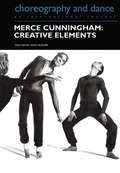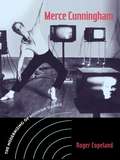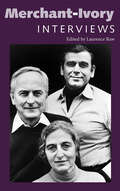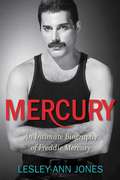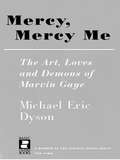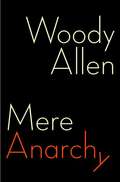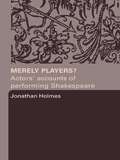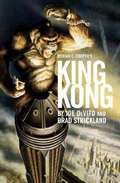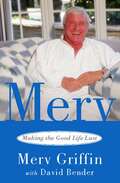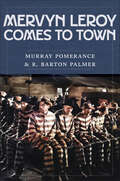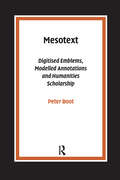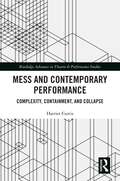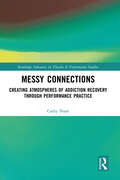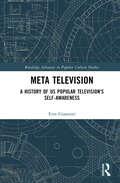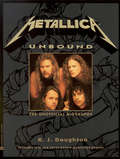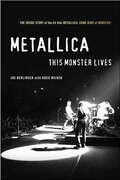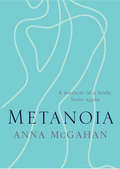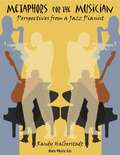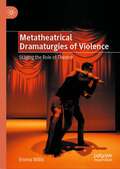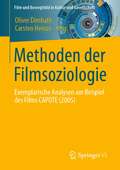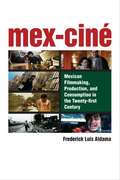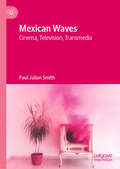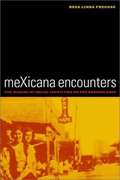- Table View
- List View
Merce Cunningham: Creative Elements (Choreography and Dance Studies Series #Vols. 4, Pts. 2.)
by Joan Acocella David Vaughan Gordon Mumma Thecla Schiphorst William Fetterman Elliot Caplan Marilyn Vaughan Drown John Holzaepfel Nelson RiveraMerce Cunningham reached the age of 75 in 1994, an age at which many creative artists are content to rest on their laurels, or at least to leave behind whatever controversies they may have caused during their careers. No so Cunningham. In the first place, his 70s have been a time of intense creativity in which he has choreographed as many as four new works a year. Cunningham is a strongly committed as ever to the discovery of new ways of moving and of making movement, refusing to be hampered by the physical limitations that have come with age. Since 1991 every new work has been made at least in part with the use of the computer program Life Forms, which enables him to devise choreographic phrases that he himself would be unable to perform - and which challenge and develop the virtuosity of the young dancers in his company.The essays collected in this special issue of Choreography and Dance were written over the last few years and discuss various aspects of the work of Cunningham as seen both from the outside and the inside.
Merce Cunningham: The Modernizing of Modern Dance
by Roger CopelandFirst Published in 2004. Routledge is an imprint of Taylor & Francis, an informa company.
Merchant-Ivory: Interviews (Conversations with Filmmakers Series)
by Laurence RawMerchant-Ivory: Interviews gathers together, for the first time, interviews made over a span of fifty years with director James Ivory (b. 1928), producer Ismail Merchant (1936–2005), and screenwriter Ruth Prawer Jhabvala (1927–2013). Beginning with their earliest work in India, and ending with James Ivory's last film, The City of Your Final Destination (2009), the book traces their career, while offering valuable insights into their creative filmmaking process. The volume serves as a corrective to the prevailing critical orthodoxy attached to Merchant-Ivory's work, which tends to regard them as being solely concerned with historically accurate costumes and settings. As independent filmmakers, they have developed an idiosyncratic approach that resists facile classification. Merchant-Ivory have insisted on maintaining their independence. More importantly, this book shows how Merchant-Ivory have always taken considerable care in casting their films, as well as treating actors with respect. This is a deliberate policy, designed to bring out one of the triumvirate's principal thematic concerns, running throughout their work—the impact of the “clash of cultures” on individuals. Partly this has been inspired by their collective experiences of living and working in different cultures. They do not offer any answers to this issue; rather they believe that their task is simply to raise awareness; to make filmgoers conscious of the importance of cultural sensitivities that assume paramount significance in any exchange, whether verbal or nonverbal.
Mercury: An Intimate Biography of Freddie Mercury
by Lesley-Ann JonesA REVEALING, INTIMATE LOOK AT THE MAN WHO WOULD BE QUEEN As lead vocalist for the iconic rock band Queen, Freddie Mercury's unmatched skills as a songwriter and his flamboyant showmanship made him a superstar and Queen a household name. But despite his worldwide fame, few people ever really glimpsed the man behind the glittering façade. Now, more than twenty years after his death, those closest to Mercury are finally opening up about this pivotal figure in rock 'n' roll. Based on more than a hundred interviews with key figures in his life, Mercury offers the definitive account of one man's legendary life in the spotlight and behind the scenes. Rock journalist Lesley-Ann Jones gained unprecedented access to Mercury's tribe, and she details Queen's slow but steady rise to fame and Mercury's descent into dangerous, pleasure-seeking excesses-- this was, after all, a man who once declared, "Darling, I'm doing everything with everyone." In her journey to understand Mercury, Jones traveled to London, Zanzibar, and India--talking with everyone from Mercury's closest friends to the sound engineer at Band Aid (who was responsible for making Queen even louder than the other bands) to second cousins halfway around the world. In the process, an intimate and complicated portrait emerges. Meticulously researched, sympathetic yet not sensational, Mercury offers an unvarnished look at the extreme highs and lows of life in the fast lane. At the heart of this story is a man . . . and the music he loved.
Mercy, Mercy Me: The Art, Loves and Demons of Marvin Gaye
by Michael Eric DysonThe best-selling Motown artist of all time, Marvin Gaye defined the hopes and shattered dreams of an entire generation. Twenty years after his tragic death-he was shot by his father-his relevance persists because of the indelible mark his outsized talent left on American culture. A transcendent performer whose career spanned the history of rhythm and blues, from doo-wop to the sultriest of soul music, Gaye's artistic scope and emotional range set the soundtrack for America's tumultuous coming of age in the 1970s. Michael Eric Dyson's searching narrative illuminates Marvin Gaye's stellar ascendance-from a black church in Washington, D. C. , to the artistic peak of What's Going On?-and charts his sobering personal decline. Dyson draws from interviews with those closest to Gaye to paint an intimate portrait of the tensions and themes that shaped contemporary urban America: racism, drug abuse, economic adversity, and the long legacy of hardship. Gaye's stormy relationships with women, including duet partner Tammi Terrell and wives Anna Gordy and Janis Hunter, are examined in light of the sexual revolution of the 1960s and 1970s. Dyson also considers family violence in the larger context of the African-American life and how that heartbreaking legacy resulted in Gaye's murder. Mercy, Mercy, Me is an unforgettable portrait of a beloved black genius whose art is reflected in the dynamism of contemporary urban America.
Mere Anarchy
by Woody Allen'I am greatly relieved that the universe is finally explainable. I was beginning to think it was me. ' Thus begins 'Strung Out', Woody Allen's hilarious application of the laws of the universe to daily life. MERE ANARCHY, Woody Allen's first new collection in 25 years, features eighteen witty, wild and intelligent comic pieces – nine of which have never been in print before. Surreal, absurd, rich in verbal play, bitingly satirical and just plain daft, this collection includes tales of a body double - mistaken for the film's star - kidnapped by outlaws; a pretentious writer forced to work on the novelisation of a Three Stooges film; a nanny secretly writing an expose of her Manhattan employers; crooks selling bespoke prayers on ebay; and how to react when you're asked to finance a Broadway play about the invention and manufacture of the adjustable showerhead. Laced with his unique brand of humour and reminiscent of some of his finest films, MERE ANARCHY is an essential collection of tales by the inimitable Woody Allen.
Merely Players?: Actors' Accounts of Performing Shakespeare
by Jonathan HolmesMerely Players? marks a groundbreaking departure in Shakespeare studies by giving direct voice to the Shakespearean performer. It draws on three centuries worth of actors' written reflections on playing Shakespeare and brings together the dual worlds of performance and academia, providing a unique resource for the student and theatre-lover alike.
Merian C. Cooper's King Kong
by Brad Strickland Joe DevitoSince its release in 1933, Merian C. Cooper's film King Kong has shocked and delighted generations of movie fans, setting the standard against which all such movies have been judged ever since. In December, 2005, Peter Jackson - whose films of the Lord of the Rings won critical acclaim and set box office records around the world - will release his version of this classic film, bringing King Kong back to the forefront of the popular imagination. Fully authorized by the estate of Merian C. Cooper, Joe DeVito and Brad Strickland's novel is a full rewrite of the original 1932 novel, bringing Cooper's original vision of King Kong back to readers and fans alike. Set in the early 1930's, it is a classic story of exploration and adventure, at the center of which is the "eighth wonder of the world" himself - Kong.
Merry Quizmas Everyone!: Christmas quizzes & games to go from the turkey to the King’s speech – have an hilarious holiday spectacular!
by Chris T MassyIt's the most hilarious time of the year...Packed full of festive pop-culture quizzes, Christmas trivia to fascinate and holly jolly games to play - as well as colouring and dot-to-dot pages to distract, and cracking cracker jokes to make you chuckle (and groan).The perfect Christmas companion for work Christmas parties, entertaining friends and family, entertaining kids (including kids), when you're too full to move, there's nothing on the TV, it's too wet for a walk and the pub isn't open yet.A book everyone will love, actually...
Merv: Making The Good Life Last
by Merv Griffin David BenderMerv Griffin will always be remembered as one of America's most beloved show business figures. With his trademark charm and business savvy, Merv built a life that defined success. From his start as a band singer, to his twenty-three years on television as host of the Emmy Award-winning Merv Griffin Show, and through his entrepreneurial years, Merv lived the American Dream. Perhaps his most enduring legacy, though, is his creation of the two most successful syndicated game shows in television history, Jeopardy! and Wheel of Fortune. Merv: Making the Good Life Last is the quintessential Horatio Alger story of a young man born into modest circumstances who, through hard work, unshakable self-confidence, and an unfailingly positive attitude, dreams his way to the top. Only to retire and do it again. In this brilliant, funny, and revealing memoir, full of great stories and even better advice, one of America's most beloved and popular show business figures tells the story of his "retirement" years, in which he made billions and became a bigger celebrity than ever. Merv: Making the Good Life Last is a great American success story, a tribute to a wonderful life, and great entertainment for Griffin's many generations of fans, who will never forget him or his legacy.
Mervyn LeRoy Comes to Town
by Murray Pomerance R. Barton Palmer Tom Conley Mark Osteen Steven Rybin Dominic Lennard Rebecca Bell-Metereau Linda Badley Lawrence Napper Daniel Varndell Adrian Danks David Desser Neil Badmington Matthew Solomon Brenda Austin-Smith Matthew Cipa Kristen Hatch Matthew H. BernsteinMervyn LeRoy Comes to Town is the first book devoted to the career of one of the director/producers who in the early years of sound cinema was instrumental in establishing the Hollywood model of production that would endure for more than half a century. As a director and producer, LeRoy was responsible for turning out more than sixty feature films in a career that spanned five decades; as a studio executive, he contributed substantially to the success of the industry during the challenging period of the Depression and also in the period of realignment and readjustment that followed the end of World War II. This book offers chapters devoted to individual films such as Little Caesar, Waterloo Bridge, 30 Seconds over Tokyo, Gypsy, and Quo Vadis.
Mesotext: Digitised Emblems, Modelled Annotations and Humanities Scholarship (Pallas Proefschriften)
by Peter BootThe most strikingly missing piece of functionality in current digital editions is that of annotation. Digital editions should offer a facility where researchers can store structured and unstructured observations with respect to the edited texts. This book discusses a number of approaches to annotation systems in the context of the study of emblems, the sixteenth and seventeenth century literary genre that joins an image, a motto and an often moralizing epigram. When handled properly, annotation can become mesotext, text positioned between the annotated texts and the scholarly articles and monographs for which the annotations provide the evidence. In a digital context, it should be possible to navigate back and forth between annotated text, annotation and article, Peter Boot was born in 1961. He studied Mathematics in Leiden and Dutch Language and Culture in Utrecht, wherehe specialised in Older Dutch Literature. Since 2003 he has been employed at the Huygens Institute, where he works as a humanities computing consultant and researcher.
Mess and Contemporary Performance: Complexity, Containment, and Collapse (Routledge Advances in Theatre & Performance Studies)
by Harriet CurtisThis book identifies and theorises mess in contemporary performance and argues that mess offers a site from which subjects might mobilise and find agency, even as the complexity (and indeed messiness) of everyday life conditions and contains.Using a queer feminist and intersectional critical framework, this book analyses how established and emerging artists mess with and mess up capitalist tendencies towards productivity, usefulness, and efficiency. Whilst the materiality of mess provides a starting point and emerges in many of the works analysed, the implications of mess as related to vulnerability, shame, and resistance occupy a larger space in the book’s chapters. These performances are messy not only in content or style; they reveal critical readings of how perceived-as messy' subjects and practices are shaped and regulated. In attending to the public, personal, and structural uses of mess, and emphasising the critical possibilities of what might otherwise be skipped over or cleared away, this book develops and opens out shared understandings of mess as creative chaos and as a practice of political action or change.This book will be of particular interest to students and scholars incontemporary theatre, art, and performance.
Messy Connections: Creating Atmospheres of Addiction Recovery Through Performance Practice (ISSN)
by Cathy SloanThis book examines performance practices that involve people in recovery from addiction, theorising such practices as recovery-engaged.Focusing on examples of practice from a growing movement of UK-based recovery arts practitioners and performers, it highlights a unique approach to performance that infuses an understanding of lived experiences of addiction and recovery with creative practice. It offers a philosophy of being in recovery that understands lived experience, and performance practice, as a dynamic system of interrelations with the human and nonhuman elements that make up the societal settings in which recovery communities struggle to exist. It thereby frames the process of recovery, and recovery-engaged performance, as an affective ecology – a system of messy connections. Building upon ideas from posthumanist research on addiction, cultural theory on identity and new materialist interpretations of performance practice, it considers how such contemporary theory might offer additional ways of thinking and doing arts practice with people affected by addiction. The discussion highlights the distinct aesthetics, ethics and politics of this area of performance practice.This study will be of great interest to students and scholars in Applied Theatre and Critical Arts and Mental Health studies.
Meta Television: A History of US Popular Television's Self-Awareness (Routledge Advances in Popular Culture Studies)
by Erin GianniniThe idea of metatextuality is frequently framed as a recent television development and often paired with the idea that it represents genre exhaustion. US television, however, with its early “live” performances and set-bound sitcoms, always suggested an element of self-awareness that easily shaded into metatextuality even in its earliest days. Meta Television thus traces the general history of US television’s metatextuality throughout television’s history, arguing that TV’s self-awareness is nothing new—and certainly not evidence of a period of aesthetic exhaustion—but instead is woven into both its past and present practice, elucidated through case studies featuring series from the 1970s to the present day—many of which have not been critically analyzed before—and the various ways they deploy metatext to both construct and deconstruct their narratives. Further, Meta Television asserts that this re- and de-construction of narrative and production isn’t just a reward to the savvy and/or knowledgeable viewer (or consumer), but seeks to make broader points about the media we consume—and how we consume it.This book explores the ways in which the current metatextual turn, in both the usual genres in which it appears (horror and sci-fi/fantasy) and its movement into drama and sitcom, represents the next turn in television’s inherent self-awareness. It traces this element throughout television’s history, growing from the more modest reflexivity of programs’ awareness of themselves, as created objects in a particular medium, to the more significant breaking of the fictive illusion and therefore the perceived distance between the audience and the series. Erin Giannini shows how the increased currency of metatextual television in the contemporary era can be tied to a viewership well-versed in its stories and production as well as able and willing to “talk back” via social media. If television reflects culture to a certain extent, this increased reflexivity mirrors that “responsive” audience as a consequence of the lack of distance that metafiction embraces.As Robert Stam traced the use—and implications—of reflexivity in film and literature, this book does the same for television, further problematizing John Ellis’s glance theory in terms of both production and spectatorship.
Metallica Unbound
by K. J. DoughtonWritten by a noted hard rock journalist who has covered the band since its inception 10 years before the book was published, this one-of-a-kind, full-color collectors' volume provides the most in-depth information on the band available anywhere. Rare and never-before-published photos. Complete discography.
Metallica: This Monster Lives
by Greg Milner Joe Berlinger“Triumphs because of the commitment and fearlessness of Metallica . . . [and] shows that tenacious reporting can still produce great narratives.” —New York TimesMetallica is one of the most successful hard-rock bands of all time, having sold more than ninety million albums worldwide. Receiving unfettered access, acclaimed filmmakers Joe Berlinger and Bruce Sinofsky followed Metallica over two and a half years as they faced personal and professional challenges that threatened to destroy the band just as they returned to the studio to record their first album in four years. While the documentary itself provides an insider’s view of Metallica, the two and a half years of production (and more than 1,600 hours of footage) garnered far more than can be expressed in a two-hour film.Berlinger’s book reveals the stories behind the film, capturing the uncertainty, and ultimate triumph of both the filming and Metallica’s bid for survival. It weaves the on-screen stories together with what happened off-screen, offering intimate details of the band’s struggle amidst personnel changes, addiction, and controversy. In part because Berlinger was one of the only witnesses to the intensive group-therapy sessions and numerous band meetings, his account is the most honest and deeply probing book about Metallica—or any rock band—ever written.“A fascinating look at the logistics of making an album and the dysfunctional family that bands can become.” —Chicago Tribune“This book should be required reading for aspiring filmmakers.” —Publishers Weekly“Berlinger takes us even deeper into the inner sanctum. . . . many events that were edited for the film, including a pivotal scene in which drummer Lars Ulrich laces into singer James Hetfield, are transcribed in full.” —USA Today
Metanoia: A Memoir of a Body, Born Again
by Anna McGahanPerhaps we have done to our bodies what we have so long done to God?We have demanded they conform to the image we find the most desirable.We have treated them as rubbish bins, weapons and punching bags.We have muted their wills until their voices have fallen silent.At 23, Anna McGahan was wrestling with the rest of the world for ownership of her femininity, sexuality and physicality. As a young actor thrust into the spotlight as a poster girl for sexual liberation – intent on exploring the next relationship, the lowest weight and the wildest high – her path pointed her to chaos, starvation and isolation.Until – unexpectedly – she met God.In this memoir, Anna shares the story of reconciling with her body, mapping its journey from another product in a marketplace, to a vessel of inherent power and worth.Metanoia is the cry of a body broken and resurrected, the song of a bird set free.
Metaphors for Musicians
by Sher Music Randy HalberstadtThis practical and enlightening book gives insight into almost every aspect of jazz musicianship---scale/chord theory, composing techniques, analyzing tunes, practice strategies, etc. For any level of player, on any instrument. Endorsed by Jessica Wiliams, Jerry Bergonzi, Bill mays, etc.
Metatheatrical Dramaturgies of Violence: Staging the Role of Theatre
by Emma WillisThis book examines a series of contemporary plays where writers put theatre itself on stage. The texts examined variously dramatize how theatre falls short in response to the demands of violence, expose its implication in structures of violence—including racism and gender-based violence—and illustrate how it might effectively resist violence through reconfiguring representation. Case studies, which include Jackie Sibblies Drury’s We Are Proud to Present and Fairview, Ella Hickson’s The Writer and Tim Crouch’s The Author, provide a range of practice-based perspectives on the question of whether theatre is capable of accounting for and expressing the complexities of structural and interpersonal violence as both lived in the body and borne out in society. The book will appeal to scholars and artists working in the areas of violence, theatre and ethics, witnessing, memory and trauma, spectatorship and contemporary dramaturgy, as well as to those interested in both the doubts and dreams we have about the role of theatre in the twenty-first century.
Methoden der Filmsoziologie: Exemplarische Analysen am Beispiel des Films CAPOTE (2005) (Film und Bewegtbild in Kultur und Gesellschaft)
by Oliver Dimbath Carsten HeinzeDie Beiträge dieses Bandes gehen aus einem Symposion zur Analyse des Spielfilms CAPOTE (2005) hervor, das Vertreterinnen und Vertreter unterschiedlicher filmsoziologischer Methoden und Zugänge zusammengebracht hat. Die Fokussierung auf einen Film gewährt einen vergleichenden Blick auf verschiedene Verfahren und die Reichweite ihrer Interpretations- und Deutungspotenziale. Unter den behandelten Ansätzen finden sich Positionen der filmgestützten Interaktionsanalyse, der Seduktionstheorie oder der biografischen Filmanalyse.
Mex-Ciné: Mexican Filmmaking, Production, and Consumption in the Twenty-first Century
by Aldama Frederick LuisMex-Ciné offers an accessibly written, multidisciplinary investigation of contemporary Mexican cinema that combines industrial, technical, and sociopolitical analysis with analyses of modes of reception through cognitive theory. Mex-Ciné aims to make visible the twenty-first century Mexican film industry, its blueprints, and the cognitive and emotive faculties involved in making and consuming its corpus. A sustained, free-flowing book-length meditation, Mex-Ciné enriches our understanding of the way contemporary Mexican directors use specific technical devices, structures, and characterizations in making films in ways that guide the perceptual, emotive, and cognitive faculties of their ideal audiences, while providing the historical contexts in which these films are made and consumed.
Mexican Waves: Cinema, Television, Transmedia
by Paul Julian SmithThis book, Mexican Waves: Cinema, Television, Transmedia, explores the dynamic landscape of contemporary Mexican audiovisual storytelling, offering an in-depth examination of the works of influential filmmakers, television creators, and transmedia artists. By analyzing the convergence of these media, the book provides a comprehensive understanding of their evolution and socio-cultural impact. Key concepts include the interplay between cinema, television, and transmedia, with chapters dedicated to the works of renowned directors like Alejandro González Iñárritu and the rise of quality television series. The book also uncovers unexpected connections between art cinema and digital platforms such as YouTube, highlighting how these media address pressing themes like feminism and queer identity. Through close textual analysis and industrial context, readers will gain insights into the innovative narratives shaping Mexican media today. This essential volume is designed for scholars and students of media studies and Latin American studies, as well as anyone interested in the transformative power of storytelling. By presenting previously unstudied primary texts now accessible via streaming, the book invites readers to engage with the vibrant and evolving world of Mexican audiovisual culture.
Mexicana Encounters: The Making of Social Identities on the Borderlands
by Rosa Linda FregosoMexicana Encounters charts the dynamic and contradictory representation of Mexicanas and Chicanas in culture. Fregoso's self-reflexive approach to cultural politics embraces the movement for social justice and offers new insights into the ways that racial and gender differences are inscribed in cultural practices.
